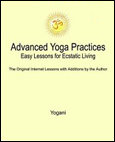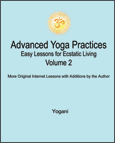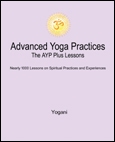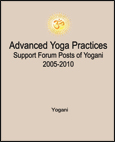|
Public Home | Plus Home | Main Lessons | Tantra Lessons | Public Forum | Plus Forum | Downloads | Books Topic Paths | Search | Training-Retreats | Testimonials | Survey | Interviews | MultiMedia | Contact | Donate |
|
Advanced Yoga Practices Note: For the Original Internet Lessons with additions, see the AYP Easy Lessons Books. For the Expanded and Interactive Internet Lessons, AYP Online Books, Audiobooks and more, see AYP Plus. Lesson 425 - Urgent Bhakti and Overdoing (Audio)
AYP Plus Additions:
From: Yogani New Visitors: It is recommended you read from the beginning of the archive, as previous lessons are prerequisite to this one. The first lesson is, "Why This Discussion?"
A: The more advanced we become, the more important self-pacing becomes, for the very reasons you are describing. With the rise of inner silence and the awakening of ecstatic conductivity (kundalini), the more intense our desire for union will become. This rise of urgent bhakti is both a cause and effect in practices. It is up to us to regulate our conduct in relation to practices, our bhakti, and life in general, so as to keep in balance. In this, we should always keep in mind the potential delayed effects that can come when diving into intense periods of practice. Throwing caution to the wind in such situations is what can lead to the cycle of energetic and emotional ups and downs you are describing. The key is to chart a course in the middle, between the highs and lows. Not always easy for most of us until we are further along in spiritual experience. Two or three years is a very short time in practices. Aim for 5-10 years of stable practice, combined with a normal life (whatever that is for you), and then results can be much smoother and more reliable. Reduce short term expectations, and all will be better. There is nothing to do except what is in front of us right now. It isn't about following impulsive urges to jump into more and more practices. This is a form of automatic yoga that does not necessarily lead to more progress. If we make stable practice the priority on our path, what we need to be doing next will happen safely and automatically. Ultimately, we are not the doers. Inner silence is. In abiding inner silence, our dharma (most evolutionary path) becomes clear. This doesn't mean we should not look before we leap. Common sense and a measured approach are our best friends on the path, especially when we are becoming more advanced. Regarding serving others, we have to take care of ourselves before we can take care of others. On the other hand, sometimes it can work the other way around, and be grounding. Sometimes by taking care of others we can take care of ourselves. Only you can know in your particular circumstances. It is suggested not to let fearful judgments rule in deciding on how to go forward. We do not self-pace in fear. Use common sense. If the energy is flowing too much, then engage in the practical measures we have discussed throughout the lessons for self-pacing and grounding. If you are finding too much sensitivity in deep meditation with mantra, it will be wise to consider doing breath meditation for a while, as discussed in Lesson 367. Likewise, it is not a good idea to push ahead aggressively with asanas, pranayama, mudras, bandhas and other practices until stability in your basic daily practice routine is established, and balanced with daily activity. Having good grounding in our life in the form of ordinary daily activity like a job, school or family is very important. There is an old saying that "a watched pot will never boil." In spiritual endeavors, the opposite can happen, with "a watched pot boiling too much." This means keeping our bhakti in perspective, relaxing our urgency as needed. Keeping a balance is essential, especially as we advance along the path with inner silence, ecstatic energies and the associated intensification of bhakti. The good news is that it all settles down as purification and opening advance. As stillness and ecstatic energy mingle, the eternal peace and natural dynamism of divine outpouring emerge. In the meantime, it is up to us to self-pace and ground. Having a lot of bhakti is great. It is essential to fuel our actions on the path. But, as we advance, it will not be helpful without a balance in our life. It is about knowing ourselves, and doing what is necessary for stable progress. No one else can do this for us. This rough spot will pass ... it is guaranteed. When the good vibes are coming back, tread through with care. Not too much up, and not too much down. Cultivate and abide in the stillness in the middle. That is what we are ... that is where the peace is, even when the world around us may be flying apart. There will be ups and downs in life, no matter how enlightened we become. That is also guaranteed. As long as we think we can eliminate the ups and downs by maneuvering our life this way or that way, we will be suffering. With practices we will get to the point where we can live through the inevitable ups and downs in abiding inner silence. Then judgment of ourselves and others fades. Judgment (identification) is the greatest cause of suffering the only cause really. That's why meditation is the most important practice. It brings us home to stillness, which ends judgment. Judgment is gradually replaced by divine flow, which is doing what is in front of us right now, living in the ups and downs of life as stillness in action. It is not a mind thing. It is about cultivating our essential "being" daily, which is pure bliss consciousness. Everything else revolves around that, lives in that, and is That. It is about sustaining balanced daily practice over the long term. That is how we become. The guru is in you.
Bhakti Related Lessons Topic Path Discuss this Lesson in the AYP Plus Support Forum Note: For detailed discussion on how bhakti evolves on our path, see the Bhakti and Karma Yoga book. For detailed instructions on building and maintaining a balanced daily practice routine with self-pacing, see the Eight Limbs of Yoga book. Also see AYP Plus. |
|
|
|
Join the Mail List:
AYP Retreats
eBooks - PDF, EPUB
FREE eBooks with
SAVE with Bundled
|

























